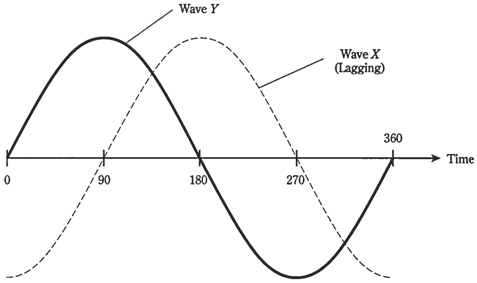Lagging phase:
Assume that wave X begins its cycle more than 180°, but less than 360 degrees, ahead of wave Y. In this situation, it is simple to imagine that wave X begins its cycle later than wave Y, by some value in between 0 to 180 degrees. Then wave X is not leading, but is lagging instead, wave Y. Figure given below shows wave X lagging wave Y by 90 °. The difference could be between 0 and 180 degrees.

Figure-- Wave X lags wave Y by 90 degrees.
You can surmise by now that leading phase and lagging phase are different ways of looking at similar "animals." In practice, alternating current sine waves are oscillating rapidly, at times thousands, millions, or even billions of times per second. If 2 waves have same frequency and different phase, how do you know that 2 wave is really leading the other by small part of the cycle, instead of lagging by a cycle and a fraction, or by a few hundred, thousand, or billion cycles and a fraction? The answer lies in effects of the waves. The engineers and technicians think of phase differences, for the sine waves having same frequency in between 0 and 180 degrees, may be leading or lagging. It hardly matters, in practice, whether one wave started a few seconds earlier or later than the other.
So, while you might think that the diagram of Figure which is given below shows wave X lagging wave Y by 270°, or that the diagram of Figure given below shows wave X leading wave Y by 270 °, you would get an odd look from an engineer if you said so loudly And if you said something like this wave is leading that one by 630 °, you might actually be laughed at.
Note that if wave X is lagging wave Y, then wave X is to the right of wave Y.